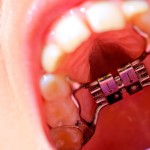
After third molars the upper permanent canines are the most commonly impacted teeth. Palatal impaction is the more common and early intervention and management is indicated. This may include extraction of the primary canines surgical exposure and orthodontic traction, surgical removal, or regular monitoring with no active treatment or adjunctive procedures such as rapid maxillary expansion (RME), transpalatal arch (TPA) or cervical-pull headgear (HG), aiming to maintain or provide additional space for the displaced canines.
The main aim of this review was to investigate the effectiveness of orthodontic procedures, with or without extraction of primary canines, for the management of displaced permanent canines in the mixed dentition.
Methods
Searches were conducted in the Medline/PubMed, Cochrane Central Register of Controlled Trials, Cochrane Database of Systematic Reviews, Scopus, Web of Science, Arab World Research Source, Clinical-Trials.gov, ProQuest Dissertations and Theses Global databases with no restrictions. Randomised clinical trials (RCTs) with at least 12 months of observation after Interceptive orthodontic treatment for the management of palatally displaced permanent canines were considered. Two reviewers independently selected studies, extracted data and assessed risk of bias using the Cochrane tool. The primary outcome of successful eruption of the permanent canine was expressed as risk ratios (RR) with 95% Confidence intervals (CI). Random effects meta-analysis was carried out where possible.
Results
- 5 RCTs involving 346 patients were included.
- Follow up ranged from 18-59 months.
- All 5 studies were considered to be at high risk of bias.
Intervention with no primary canine extraction ‘v’ no intervention.
- There was a statistically significant benefit in the successful eruption of permanent canine with
- RME; RR= 4.813 (95%CI; 1.633 to 14.187).
- HG; RR= 2.265 (95%CI; 1.249 to 4.106) and
- combined use RME &HG; RR=2.357 (95%CI; 1.320 to 4.209).
Intervention with primary canine extraction ‘v’ no intervention.
- There was a statistically significant benefit in the successful eruption of permanent canine with
- RME followed by TPA placement and extraction of the primary canines; RR =2.900 (95%CI;1.576 to 5.336).
- HG; RR = 2.417 (95%CI; 1.511 to 3.863) and
- TPA followed by extractions (RR=2.870; 95% CI= 1.537 to 5.358).
Intervention with primary canine extraction ‘v’ extraction only.
- There was no statistical benefit for RME followed by TPA or TPA alone, compared to extraction of primary canines only.
- There was a benefit for extraction followed HG compared to extraction only RR=1.413 (95%CI:1.062 to 1.880).
Conclusions
The authors concluded: –
RME, TPA and HG can significantly increase the rate of normal eruption of PDC compared to no intervention. However, when compared to extraction, no differences were noted, except for HG combined with primary canine extraction.
Comments
It has been estimated that between 1-3 % of the population have ectopic maxillary canines. It was also though that the majority of canines were displaced palatally although this is now being questioned following the use of computerised tomography. The extraction of the primary canines has been advocated since the late 1980s. However, a range of alternative interceptive interventions are now in use and in addition to this current review a Cochrane review is also underway (Parkin et al). The authors of this review have searched a number of international databases and restricted inclusion to RCTs identifying only 5 trials with all 5 being considered to be at high risk of bias. While the review presents data on a number of comparisons most are based on the findings of single studies so the conclusions should be considered cautiously. Further high quality well reported studies of appropriate size are needed.
Links
Primary Paper
Al Naqbi IA, Kaklamanos EG, Papadopoulou AK, Athanasiou AE. Orthodontic Procedures, With or Without Extracting Primary Canines, for the Interceptive Management of Palatally Displaced Permanent Canines: A Systematic Review. J Dent Child (Chic). 2020;87(2):60-68.
Other references
Parkin N, Bazargani F, Benson PE, Atwal A. Interventions for promoting the eruption of palatally displaced permanent canine teeth, without the need for surgical exposure, in children aged 9 to 14 years. Cochrane Database of Systematic Reviews 2017, Issue 10. Art. No.: CD012851. DOI: 10.1002/14651858.CD012851.
Dental Elf 21st Aug 2017
Interceptive primary canine extraction for palatally displaced permanent canines
